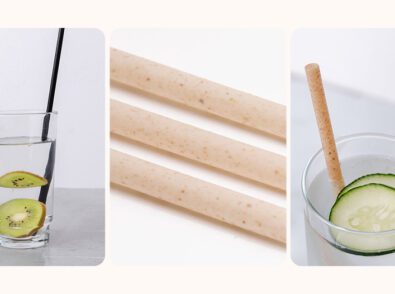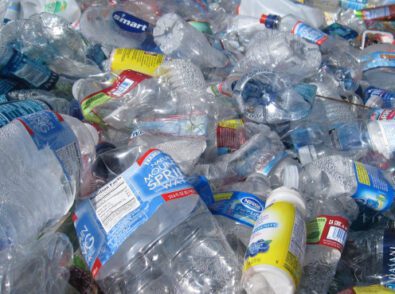What is Aircarbon?

Finding viable alternatives to petroleum-based plastics is essential to fighting climate impact. In the last few years, we’ve seen significant advancements in materials engineering, but one of the most exciting to date is AirCarbon.
Created by Newlight Technologies, AirCarbon is a plastic-like, carbon-negative material made from ocean microbes, methane, and other waste greenhouse gases. The resulting material sequesters significantly more carbon than it produces.
Carbon Trust, an independent authority in the UK, found that for every kilogram of AirCarbon produced, the equivalent of 88 kilograms of CO2 was sequestered. Because methane is consumed to make the product and it’s manufactured in a factory powered by renewable energy, the resulting product is carbon negative.
AirCarbon is used to make single-use products for food service, such as AirCarbon cutlery and AirCarbon straws. Newlight also makes sunglasses, handbags, and items typically made from animal leather under the brand name Covalent.
Today, we’ll dive deeper into what AirCarbon is, how it’s made, the innovation behind it, and why it’s the way of the future.
What is AirCarbon?
AirCarbon is made from Polyhydroxybutyrate (PHB). Though Newlight did not invent PHB, they innovated AirCarbon leveraging PHB, using methane from defunct coal mines as a catalyst and manufacturing it in a plant powered by renewable energy. The result is a certified carbon-negative product, AirCarbon.
PHB exists in nature. Trees use greenhouse gases, like CO2, to generate leaves. Coral pulls CO2 out of ocean water to replicate and grow. PHB is created from this process. Newlight used these principles to form the basis of their research.
They noted how a particular strain of ocean microbe consumed methane, resulting in PHB, a compound that would then store the methane to use as energy.
Scientists at Newlight replicated the process in a tank filled with ocean water and methane from a defunct coal mine, producing AirCarbon within the ocean bacteria. Following extraction, the material was processed into a powder, which could then be melted, purified, and molded into various shapes.
The methane used to produce the AirCarbon would otherwise be released into the atmosphere. Therefore, AirCarbon and its resulting products are taking methane out of the air. Methane contributes about 25% to global warming from greenhouse gas, so anything we can do to reduce it is a step in the right direction.
Simply put, AirCarbon is air and carbon dissolved in water. That’s why it’s called AirCarbon.
Because AirCarbon is created using microbes, it decomposes naturally when exposed to the same microbes, like a leaf decomposes when it falls to the forest floor or how paper breaks down in ocean water.
AirCarbon is also highly durable and can withstand extreme hot and cold temperatures. It can be washed, run through a dishwasher, reused, and recycled. AirCarbon straws and other single-use PHB products can be disposed of in home compost, making it more versatile than many bioplastics for this and other applications.
What Products Can Be Made From PHB?
Almost anything made from petroleum-based plastics or bioplastics can be made from PHB. AirCarbon straws and AirCarbon cutlery are among the products Newlight currently makes.
PHB is non-allergenic and food safe, even for highly acidic or fatty substances. PHBs durability also makes it a viable and much safer alternative to PP for durable food packaging.
In addition to single-use products for food service, here are a few other products that can be made from PHB:
- Woven fabric for clothing
- Leather-like fabric for clothing and other items
- Biomedical fabrics and sutures
- Biodegradable implantable medical devices
- Drug delivery systems
- Reusable dishes and cutlery
- Drinking cups
- Food and beverage packaging
- Durable food storage
- Agricultural fertilizer encapsulations
PHA vs. PHB: What’s The Difference?
PHA and PHB are part of the same family of compostable bioplastics. They are both biodegradable, home and industrial-compostable, and can be broken down in various natural environments.
The fact that PHA and PHB can be disposed of in home compost is a significant advantage over other bioplastics, especially where single-use items are concerned. The less consumers have to think about what to do with their food service disposables, the better.
Chemically, PHA is a more complex substance. Despite that, the organisms used to make PHA are more common, and production can be scaled up more easily than it can for PHB.
PHB requires very specific environmental conditions and microorganisms to produce. As such, it is not as easily scalable as PHA, so we don’t see as much of it in the market. As Newlight Technologies continues to innovate ways to scale, produce more AirCarbon, more of the raw material, and manufacture more products from it, we will likely begin to see more companies making products from it.
Benefits of AirCarbon PHB
Though AirCarbon isn’t terribly well-known to the general public, it’s been making waves in the biomaterials space since 2013, winning numerous awards for material innovation, leadership, and technology excellence.
In 2019 Newlight built their first commercial-scale production system, helping them scale their operations to meet the growing demand for safe, sustainable plastic alternatives.
Since PHB is made in nature and within the human body, it offers endless possibilities for novel materials that can replace carbon-intensive products and virtually anything made from a non-renewable source.
- PHB is home compostable and industrial compostable.
- PHB is biodegradable in almost any natural environment, including the ocean.
- Products made from PHB are highly durable, reusable, and dishwasher-safe.
- PHB products (including textiles) can be recycled or melted down and reprocessed into new products.
- PHB does not require food crops or agriculture to produce.
- Textiles made from PHB are hypoallergenic and biocompatible.
- PHB will anaerobically biodegrade 90% in 10 days at a moderate temperature range (does not require extremely high heat). To compare, PLA degrades by 7% in 90 days under the same conditions.
- AirCarbon has a carbon-negative footprint, certified by Carbon Trust according to PAS 2050 2011, the global standard for assessing GHG emissions in a product’s lifecycle.
Knowing what we know about AirCarbon, the environmental benefits are clear. No other bioplastic has the versatility or potential of AirCarbon. Based on Newlight’s unique process and the fact that they power their manufacturing plants with renewable energy, wider adoption would remove more greenhouse gases from the environment than just about every other effort combined.
References
- https://www.newlight.com/
- https://www.carbontrust.com/what-we-do/assurance-and-labelling/the-carbon-trust-certified-organisations
- https://www.prnewswire.com/news-releases/newlight-technologies-aircarbon-material-has-been-certified-carbon-negative-by-the-carbon-trust-301138193.html
- https://www.aircarbonfoodware.com/
- https://covalentfashion.com/
- https://www.ncbi.nlm.nih.gov/pmc/articles/PMC9571180/
- https://www.usgs.gov/news/featured-story/climate-warming-likely-cause-large-increases-wetland-methane-emissions
- https://crimsonpublishers.com/ntnf/fulltext/NTNF.000546.php
- https://www.sciencedirect.com/science/article/pii/S2666016420300128
- https://www.bsigroup.com/globalassets/localfiles/en-th/carbon-footprint/pas-2050-2011-guide.pdf




